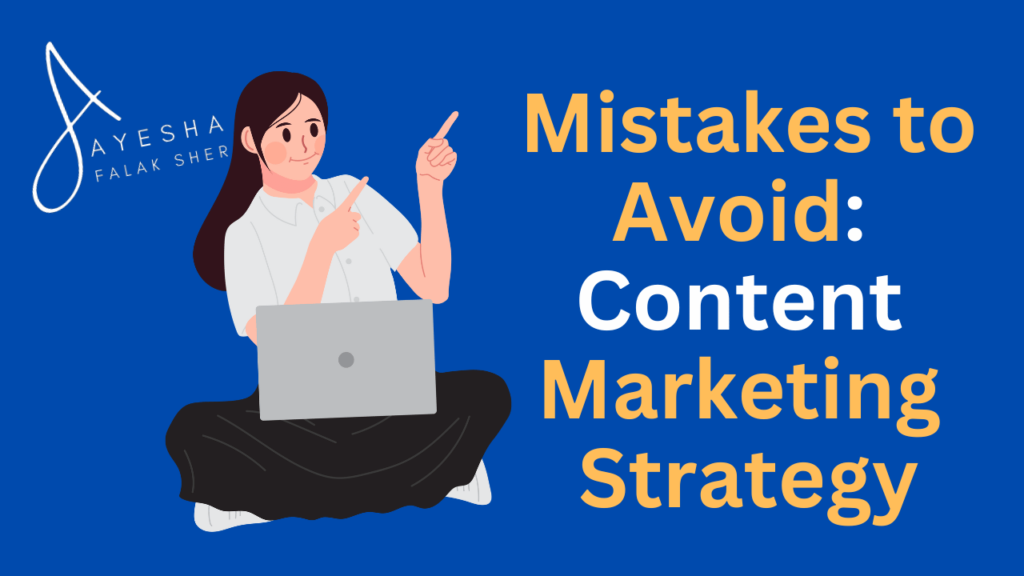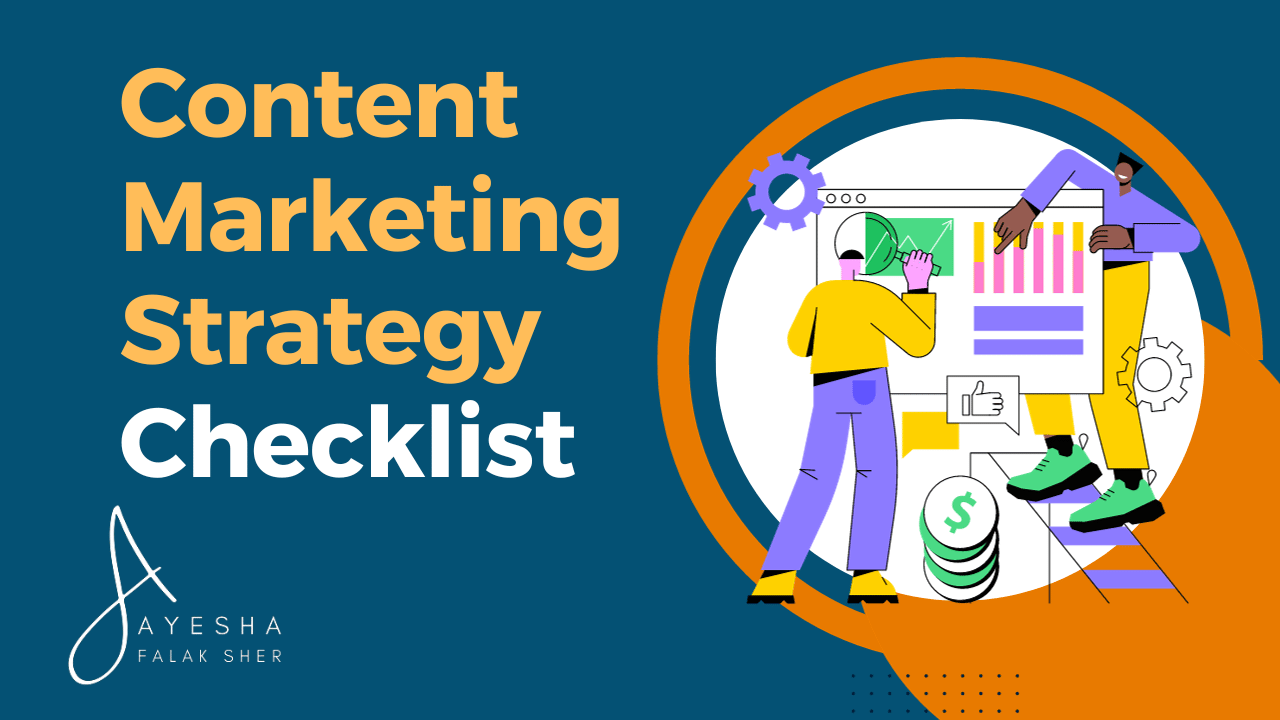Have you ever felt lost in the sea of online content?
Today, with so much information everywhere, making your message heard can be tough.
That’s where a good content marketing strategy comes in.
Content marketing is a powerful tool for businesses of all sizes.
It helps you connect with your audience, enhance brand awareness, and drive growth.
It’s not about fancy tricks or being the loudest.
It is about understanding your audience, meeting their needs, and creating content they like.
Think of it as a friendly chat, connecting with your audience and giving them useful stuff.
In this comprehensive guide, I will explore the ins and outs of creating a successful content marketing strategy.
Whether you’re a small business owner, a marketing professional, or just curious about content marketing, this article will equip you with the necessary knowledge and tools.
Let’s start and learn how to make an effective content marketing strategy to enhance your online business.
Table of Contents
ToggleWhat is Content Marketing Strategy?
Content marketing strategy is a plan or approach that outlines how a business or organization intends to create, distribute, and manage content to achieve specific marketing goals.
It involves strategically using various types of content, such as blog posts, articles, videos, infographics, and more, to attract and engage a target audience.
The primary objectives of a content marketing strategy typically include:
- Building Brand Awareness: Creating content that showcases the brand’s values, expertise, and personality to increase its visibility and recognition.
- Audience Engagement: Developing content that resonates with the target audience and encourages them to interact, share, and connect with the brand.
- Lead Generation: Using content to capture and nurture potential customers’ information through the sales funnel.
- Establishing Authority: Positioning the brand as a trusted source of information and expertise in its industry or niche.
- Driving Website Traffic: Using content to attract visitors to the company’s website to learn more about products or services.
- Improving SEO: Optimizing content to rank well in search engine results, increasing organic visibility.
- Customer Education: Providing valuable information to help customers make informed decisions and get the most out of their purchases.
A well-planned content marketing strategy aligns content creation with the overall marketing objectives of a business and ensures that content is created and distributed consistently to achieve those objectives.
Top 16 Powerful Ways to Craft Effective Content Marketing Strategy

Here are the most recommended 16 ways to use while making a content marketing strategy.
1. Understanding Your Audience
Before you start creating a content marketing strategy, it’s crucial to understand your audience.
Conducting thorough audience research sets the stage for a successful content marketing strategy.
Here are a few things to keep in mind when doing research for the target audience:
Demographics: Who Are Your Ideal Customers?
Start by gathering basic demographic information about your audience.
This includes age, gender, location, income, and education levels.
For instance, if you run an online clothing store, your audience might be primarily young adults aged 18 to 35 living in urban areas.
Psychographics: Uncovering Mindsets and Values
Go beyond demographics to explore the psychographics of your audience.
This means understanding their beliefs, values, interests, and pain points.
For example, building on the clothing store example, your audience may value sustainability and seek affordable yet stylish clothing options.
Pain Points and Challenges: Addressing Needs
Identifying your audience’s pain points and challenges is vital and is the foremost demand of a good content marketing strategy.
What problems can your products or services solve for them?
For our clothing store, your audience might struggle with finding eco-friendly fashion within their budget.
2. Building Audience Personas
With research in hand, it’s time to create audience personas because it’s the base of a powerful content marketing strategy.
These are fictional representations of your ideal customers based on your research.
Creating Detailed Personas
Let’s name one of your personas “Eco-Conscious Emily.”
Emily is a 26-year-old urban dweller who values sustainability.
She is concerned about the environmental impact of fast fashion and seeks affordable, eco-friendly clothing options.
Aligning Content with Personas
By understanding Emily’s needs, you can tailor your content to address her concerns.
So, create content highlighting your store’s eco-friendly clothing line, affordability, and the positive impact of choosing sustainable fashion.
Identifying and Catering to Unique Audience Needs
Recognize that each persona may have different needs.
For Emily, your content could include articles on the benefits of sustainable fashion, guides on building a versatile, eco-friendly wardrobe, and product showcase with affordable options.
3. Setting Clear Objectives and Goals
Now that you know your audience, set clear objectives and goals for your content marketing strategy.
SMART goals are Specific, Measurable, Achievable, Relevant, and Time-bound.
- Specific: Clearly define what you want to achieve. For instance, “Increase website traffic by 20% in the next six months.”
- Measurable: Establish how you will measure success. In this case, it’s through website traffic metrics.
- Achievable: Ensure your goals are realistic and attainable within your resources and timeframe.
- Relevant: Goals should align with your business objectives. If your objective is to increase online sales, your content goal might be to generate leads through informative blog posts.
- Time-bound: Set a deadline for achieving your goal, creating a sense of urgency.
4. Aligning Content Goals with Business Objectives
Your content goals should directly contribute to your broader business objectives.
If your goal is to increase brand awareness, create content that educates and engages your audience without pushing for sales.
- Increasing Brand Awareness: Focus on creating content that raises brand awareness, such as thought leadership articles, educational blog posts, and engaging social media content.
- Driving Lead Generation: To generate leads, create content that captures email addresses through downloadable guides, webinars, or free trials.
- Boosting Customer Retention: For businesses looking to retain existing customers, provide ongoing value through content, such as tutorials, product updates, or customer success stories.
5. Metrics for Measuring Success
Key Performance Indicators (KPIs) are essential for tracking your progress and measuring success.
- Website Traffic: Monitor the number of visitors to your website over time using tools like Google Analytics.
- Conversion Rate: Keep an eye on the percentage of visitors who take desired actions, such as signing up for a newsletter or purchasing.
- Email Subscriptions: Measure the growth of your email subscriber list as a sign of audience engagement.
- Social Media Engagement: Track likes, shares, comments, and overall engagement on your posts to gauge audience interaction.
- Sales Revenue: Assess the revenue generated through your content marketing efforts, connecting it to specific campaigns or content pieces.
6. ROI Measurement
Calculating the Return on Investment (ROI) of your content marketing strategy ensures that your efforts provide a positive return on your investment of time and resources.
ROI Formula: ROI = (Net Profit / Cost of Investment) x 100
For Example
If you spent $1,000 on content creation and generated $5,000 in sales directly attributed to that content, your ROI would be 400%.
By conducting thorough research and aligning your content with your audience’s needs and your business objectives, you lay the groundwork for success.
7. Competitive Analysis
Performing your competitive analysis before making your ultimate content marketing strategy is important.
Identifying Your Main Competitors
1. Direct Competitors: In the Same Boat
Direct competitors are like fellow sailors in your boat; they’re businesses that offer similar products or services, aiming for the same group of customers.
Recognizing these competitors is crucial for understanding your competitive environment.
Example:
Let’s say you own a local coffee shop called “Bean Delight.”
Your direct competitors would include nearby coffee shops like “Café Aroma” and “Coffee Haven” serving similar drinks and snacks.
2. Indirect Competitors: Playing a Different Game
Indirect competitors may not offer the same things you do, but they’re still players in the same arena.
They compete for your audience’s attention and resources.
Recognizing these competitors broadens your perspective on the competitive field.
Example:
In the case of “Bean Delight,” indirect competitors could include local tea shops, convenience stores selling pre-packaged coffee, and even online coffee subscription services.
Even though they’re not offering precisely what you do, they’re still after the same coffee-loving customers.
Analyzing Your Competitors’ Content
With your competitors identified, let’s look at the content they create.
Analyzing their content can reveal valuable insights into what works and what doesn’t in your field.
1. Types and Formats of Content: How They Communicate
Different competitors might use different ways to communicate with their audience.
Pay attention to these and see how effective they are.
Example:
While “Café Aroma” might focus on visually appealing Instagram posts featuring latte art and pastries, “Coffee Haven” might concentrate on informative blog articles about coffee bean origins and brewing techniques.
Each approach caters to a different audience.
2. Content Quality and Engagement: How Their Audience Reacts
Not all content is equally impactful.
Take a moment to assess the quality of your competitors’ content and how their audience interacts with it.
Example:
“Coffee Haven” consistently receives likes, shares, and comments on their Facebook posts about coffee facts.
This engagement indicates a strong connection with their audience.
Meanwhile, “Café Aroma” earns praise for its visually pleasing latte art on Instagram, demonstrating the power of appealing visuals.
3. Identifying Content Gaps and Opportunities
Competitor analysis is not just about keeping an eye on your rivals; it’s also about finding gaps in their strategies that you can leverage.
Explore Hidden Topics
Explore areas your competitors might not have covered or haven’t explored deeply.
These uncharted territories can provide opportunities to create unique and valuable content.
Example:
“Café Aroma” and “Coffee Haven” produce content about coffee brewing methods, but neither has ventured into the world of home coffee roasting.
This presents an opportunity to create informative content about roasting coffee beans at home, catering to coffee enthusiasts interested in this skill.
4. Niche-Specific Angles
Consider niches or unique angles within your industry that your competitors might have overlooked.
These distinct paths can help you establish a unique identity in the market.
Example:
If “Bean Delight” discovers that its competitors haven’t explored the organic coffee market, it can create content focused on the benefits of organic beans, sustainable farming practices, and the journey from farm to cup.
This niche angle can attract eco-conscious coffee enthusiasts.
8. Content Planning and Ideation: Building Your Content Strategy
An effective content marketing strategy involves diversifying content types, creating a well-structured content calendar, and employing effective brainstorming techniques.
Let’s explore these components to ensure your content marketing strategy journey is well-guided.
Diversifying Content Types
Content diversity is like having a toolbox with various tools – it allows you to engage with your audience using different mediums. Let’s explore four essential content types:
- Blog Posts
- Videos
- Infographics
- Podcasts
- eBooks
Creating a Detailed Content Calendar
A well-structured content calendar keeps your content marketing efforts organized and on track.
Here are key considerations:
- Editorial calendar tools.
- Consistency in publishing.
- Effective brainstorming techniques.
- Collaborative ingenuity sessions.
- User-generated content ideas.
9. Keyword Research and SEO Optimization
Keyword research and SEO optimization are two fundamental pillars of content marketing strategy, digital marketing and online visibility.
Let’s dig into each of them briefly:
SEO Optimization:
SEO (Search Engine Optimization) is optimizing your online content and website to rank higher in search engine results pages (SERPs).
It involves various strategies and techniques, with keyword optimization crucial.
Once you’ve identified relevant keywords through research, you can strategically incorporate them into your content, Meta tags, headers, and URLs.
Additionally, optimizing images, improving site speed, enhancing user experience, and building quality backlinks are all essential aspects of SEO.
The goal is to make your website more appealing to search engines, thus improving its visibility to potential visitors.
Keyword Research:
Keyword research involves identifying your target audience’s words and phrases when searching for online information, products, or services.
This step is crucial because it helps you understand what topics and terms are relevant to your business or content.
Conducting thorough keyword research lets you discover your potential customers’ language and tailor your content to meet their needs effectively.
Effective keyword research considers factors like search volume (how often a keyword is searched for), keyword competition, and user intent (the reason behind the search).
With this knowledge, you can select the most appropriate keywords to optimize your content for search engines, ultimately driving more organic traffic to your website.
Keywords are two types:
- Long tail keywords
- Short tail keywords
| Aspect | Short-Tail Keywords | Long-Tail Keywords |
| Length | Typically, 1-3 words | Comprise 3 or more words |
| Search Volume | High search volume | Lower search volume |
| Competition | High competition | Lower competition |
| Specificity | Less specific, broad | Highly specific, narrow |
| Intent | Often informational | Often transactional or specific |
| Examples | “Running shoes” | “Best lightweight running shoes” |
| “Digital camera” | “Nikon digital camera under $500” | |
| “Healthy recipes” | “Low-carb vegetarian dinner ideas” |
Keyword’s Role in Content Strategy
Keywords are the compass that guides your content through the vast digital landscape.
They play a fundamental role in your content marketing strategy by helping your content get discovered by search engines and, in turn, by your audience.
Choosing the right mix of short-tail and long-tail keywords depends on your content and target audience.
Long-tail keywords often prove valuable for niche or specialized content.
Tools for Comprehensive Keyword Research
To navigate the world of keywords effectively, you’ll need the right tools to uncover valuable insights. Two essential tools for keyword research are Google Keyword Planner and SEMrush.
1. Google Keyword Planner
Let’s say you run an online bookstore and want to write a blog post about “classic literature.”
Using Google Keyword Planner, you can enter the term “classic literature” to discover related keywords, their search volumes, and competition levels.
You might find variations like “best classic literature books” or “classic literature reading list.”
2. SEMrush: Your SEO Companion
Imagine you manage a tech review website and plan to write a review of the latest smartphone.
With SEMrush, you can analyze your competitors’ websites to identify the keywords they are ranking for.
Examining competing articles about the same smartphone can uncover keywords that resonate with your audience.
On-Page SEO Techniques
Once you’ve identified your target keywords, it’s time to implement on-page SEO techniques to optimize your content for search engines.
1. Optimizing Meta Tags: Signposts for Search Engines
Meta tags provide search engines with valuable information about your page’s content. They include:
- Title Tag: This is the title of your webpage and often appears as a clickable link in search results. If your blog post is about “10 Tips for Healthy Eating,” your title tag could be “Top 10 Tips for Healthy Eating – Expert Advice for a Balanced Diet.”
- Meta Description: This summary of your content appears below the title in search results. Your Meta description could be “Discover expert tips for maintaining a balanced diet and making healthy eating choices. Learn how to improve your nutrition effortlessly.”
2. Internal Linking Strategies: Building Pathways
Internal linking involves connecting one page of your website to another.
It serves two primary purposes: improving navigation for your readers and enhancing SEO.
Example:
Suppose you have a blog post about “Benefits of Yoga,” within that article, you mention “mindfulness meditation.”
If you have another article about “Mindfulness Meditation Benefits,” you can link to it in the yoga post.
This internal link helps readers easily access related content, enhancing their experience on your website.
Moreover, search engines recognize these links, allowing them to understand the structure and relevance of your content.
10. Content Creation and Production
Creating content that resonates with your audience requires a blend of art and strategy.
Use storytelling because it is a powerful tool for capturing your audience’s attention and conveying your message effectively.
Moreover, introduce relatable characters or personas in your content.
Describe their challenges, aspirations, and how your product or service can improve their lives.
Consider talking about the emotions of your audience.
Share experiences, anecdotes, or testimonials that evoke joy, empathy, or inspiration.
Additionally, add visuals.
Visual content is a vital component of content marketing strategy.
It complements your written content and enhances engagement.
11. Content Distribution and Promotion
Selecting the appropriate distribution channels ensures your content reaches its intended audience effectively.
Let’s explore two powerful distribution channels: social media platforms and email newsletters.
Social Media Platforms
Social media platforms are dynamic spaces where people engage, share, and discover content.
Choose the platforms that align with your target audience and content type.
Example:
Suppose you’re promoting a fashion brand targeting young adults interested in streetwear.
Platforms like Instagram and TikTok, known for their visual and trendy content, would be ideal.
Email Newsletters
Email newsletters allow you to engage with your audience directly.
They are particularly effective for sharing in-depth content and updates and building a loyal readership.
Example:
If you manage a blog on personal finance, you can send out a weekly newsletter featuring articles on budgeting, saving, and investment tips.
Subscribers receive valuable financial insights directly in their inboxes.
12. Engaging with Your Audience
Creating a thriving community around your content is akin to nurturing a garden.
But you have to earn the trust of your audience.
Engaging with your audience starts with acknowledging their comments and feedback.
Responding promptly and thoughtfully can foster a sense of connection and trust.
Example:
Suppose you run a blog about sustainable living, and a reader leaves a comment on your article about reducing plastic waste, sharing their own experiences and seeking advice.
Respond by thanking them for contributing, sharing tips, and inviting further discussion.
These are a few steps that you can follow to increase your engagement level with your audience:
- Webinars and Q&A sessions provide an excellent platform for direct interaction with your audience.
- Social listening tools enable you to monitor online conversations related to your brand and industry.
- Keeping tabs on mentions of your brand across social media, blogs, and forums provides valuable insights.
- Monitoring discussions within your industry helps you stay informed about trends, competitors, and emerging opportunities.
- User-generated content (UGC) involves your audience creating and sharing content related to your brand.
- Empower your audience to contribute their content, whether it’s reviews, testimonials, or creative pieces related to your brand or products.
- Highlighting user stories that reflect positive experiences with your brand can build trust and credibility.
13. Analytics and Measurement
Before delving into analysis, you must establish a solid foundation with comprehensive tracking tools.
Here, we’ll explore using Google Analytics and Content Management System (CMS) analytics.
Google Analytics
Google Analytics is a robust tool that provides detailed data about your website’s performance.
It offers invaluable insights into your audience, content, and website traffic.
Example:
Imagine you manage an e-commerce website selling outdoor gear.
Google Analytics can reveal how many visitors your site receives, where they come from, how long they stay, and which products they view or purchase.
Content Management System (CMS) Analytics
Many CMS platforms offer built-in analytics that focus specifically on content performance.
These analytics provide data on individual pages, blog posts, and more.
Example:
If you run a blog using WordPress, you can access content-specific analytics.
They can tell you which articles receive the most views, comments, and shares, helping you identify your most popular content.
14. Analyzing Content Performance: Evaluating Success
Analyzing content performance involves scrutinizing key performance indicators (KPIs) and identifying successful content that resonates with your audience.
Analyzing KPIs: Metrics that Matter
Key performance indicators are metrics that help you gauge the success of your content.
They vary based on your goals and can include:
- Traffic Metrics: These metrics measure the quantity of visitors to your site, including:
- Page Views: The number of times a page is viewed.
- Unique Visitors: The number of distinct individuals who visit your site.
- Bounce Rate: The percentage of visitors who leave your site after viewing only one page.
- Engagement Metrics: These metrics assess how actively visitors interact with your content, including:
- Time on Page: The average time visitors spend on a page.
- Comments: The number of user comments on your content.
- Shares: How often is your content shared on social media?
- Conversion Metrics: These metrics measure actions that align with your goals, such as:
- Click-Through Rate (CTR): The percentage of users who click on a specific link.
- Conversion Rate: The percentage of visitors who complete a desired action, like purchasing or signing up for a newsletter.
Example:
A KPI like “Conversion Rate” would be vital for operating an online bookstore.
You can track how many visitors purchase after reading a book review on your site.
Identifying Successful Content: What Works
Analyzing KPIs helps you identify which content is successful and resonates with your audience.
Successful content often aligns with your goals and generates the desired outcomes.
Example:
If you run a fitness blog and notice that articles about “At-Home Workouts” consistently have higher engagement and lower bounce rates than other topics, you can deduce that this type of content is successful.
Iterating and Optimizing Content
The analysis doesn’t end with data collection—it is the foundation for iterative improvements.
Data-driven content adjustments, A/B testing, and experimentation are essential for optimization.
15. Budgeting and Resource Allocation
Allocating resources effectively is the cornerstone of a well-rounded content marketing strategy.
Here, I’ll explore how to efficiently allocate your budget and personnel.
Budget Distribution
When allocating your budget, consider the various components of your content marketing strategy.
These may include content creation, distribution, promotion, analytics tools, and personnel costs.
Example:
Suppose you run a small e-commerce business selling handmade jewelry.
In that case, you might allocate a significant portion of your budget to product photography and content creation to showcase your products effectively.
Personnel Allocation
Assigning the right people to the right roles is essential.
Ensure your team possesses the skills to execute your content strategy effectively.
Example:
If you operate a travel blog, you might need a content writer with travel expertise, a graphic designer for visuals, and a social media manager to handle distribution and engagement.
Budgeting for Content Marketing
Budgeting for content marketing involves understanding the costs associated with your strategy.
Fixed and Variable Costs
- Fixed Costs: These are consistent expenses that remain stable over time. Examples include full-time team members’ salaries, analytics tool subscription fees, and website hosting costs. This is a fixed cost if you employ a content writer on a monthly salary. Regardless of your content output, you’ll pay the same amount.
- Variable Costs: These expenses fluctuate based on your content production and distribution. Examples include freelance writer fees, paid advertising, and graphic design fees for individual projects. If you hire a freelance graphic designer for a specific infographic, the designer’s fee is a variable cost directly tied to that project.
16. Scaling Your Content Strategy
Expanding your content offerings involves increasing the quantity and variety of content you produce.
As your content strategy grows, producing more content becomes essential.
However, maintaining quality is paramount.
Moreover, you can diversify content formats to cater to different audience preferences.
This might involve incorporating videos, infographics, podcasts, and more into your strategy.
Example:
Suppose you manage a food blog that traditionally publishes one recipe per week.
To scale up, you might aim to publish two recipes per week without compromising the quality of your culinary creations.
Example:
If you run a travel website, consider expanding beyond written articles to include travel vlogs, destination guides in video format, and audio podcasts featuring travel stories and tips.
Challenges and Pitfalls That Can Meet Your Way While Making Content Marketing Strategy

Mistakes are a part of any journey, and content marketing is no exception.
Here are some common mistakes content marketers make and how to avoid them.
1. Lack of Consistency
Inconsistent content production can leave your audience wondering when they’ll hear from you next.
This can lead to a loss of interest and engagement.
Example:
Imagine you manage a fashion blog and publish articles regularly for a few months.
However, you stopped posting for several months without explanation due to other commitments.
Your audience may lose interest and seek fashion advice elsewhere.
Create a content calendar and stick to a consistent posting schedule.
Even if it means producing fewer pieces, reliability builds trust with your audience.
2. Ignoring Audience Feedback
Failing to listen to your audience’s feedback and preferences can result in content that doesn’t resonate with them.
Example:
If you run a YouTube channel about technology reviews and your viewers consistently request videos on a particular brand or product category, ignoring these requests may reduce engagement and subscriber attrition.
Actively engage with your audience through comments, surveys, and social media interactions.
Use their feedback to shape your content strategy and address their interests.
3. Overcoming Challenges
Content marketing is a dynamic field, and challenges are bound to arise.
Here’s how to build resilience and navigate the obstacles.
Content marketers often face unexpected obstacles, from changes in search engine algorithms to shifts in audience preferences.
The travel industry experienced a significant setback during the COVID-19 pandemic, with restrictions limiting travel.
Travel bloggers had to adapt by creating content focused on staycations, travel planning for the future, or sharing personal travel memories.
Case Studies of Successful Content Strategies

Let’s explore some real-world case studies to understand effective content marketing strategies.
Example 1: Red Bull’s Content Marketing Triumph
Red Bull is renowned for its content marketing prowess.
They transformed from an energy drink manufacturer to a media powerhouse.
Their “Red Bull Media House” produces high-quality content about extreme sports, adventure, and lifestyle.
They’ve built a loyal following and extended their brand beyond beverages by aligning their content with their target audience’s interests.
Example 2: HubSpot’s Inbound Marketing Success
HubSpot, a marketing software company, utilized inbound marketing to establish itself as an industry authority.
Their blog, ebooks, webinars, and free tools provide marketers and business owners valuable resources.
By consistently delivering insightful content, they’ve attracted a substantial audience and turned many readers into customers.
Example 3: Blendtec’s “Will It Blend?” Viral Campaign
Blendtec, a blender manufacturer, created a viral sensation with their “Will It Blend?” video series.
These videos showcased their blenders blending unusual items like smartphones and golf balls.
The entertaining and creative approach garnered millions of views and boosted their blender sales significantly.
Summing Up!
A well-crafted content marketing strategy is a powerful tool in today’s digital landscape.
Consistency is key to maintaining audience trust, and data-driven decision-making is essential for optimization.
The challenges and pitfalls we’ve explored are not roadblocks but opportunities for growth and learning.
I encourage you to take the insights gained here and implement them.
As we part ways, keep in mind that content marketing is a dynamic field, ever-evolving to meet new trends and technologies.
Now, it’s your turn!
Take what you’ve learned and use it.
Whether you’re a business trying to get noticed online or a blogger looking to connect with more people, a good content plan can make a difference.
And if you liked what you read here, please let us know in the comments.
I’d love to hear from you!
Good luck with your content marketing adventure!
If you’re looking for a content writer, I’m here to help.
I’m Ayesha Falak Sher, and I can assist you with creating the content you need.
Whether it’s articles, blog posts, or website content, I can craft it for you.
Let’s work together to achieve your content goals.









